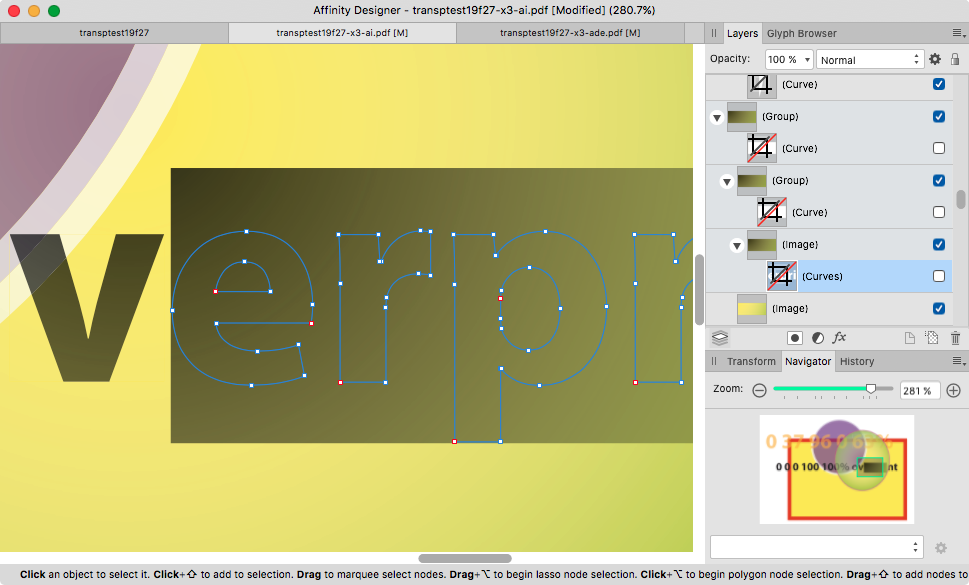Search the Community
Showing results for 'frustrate*' in content posted by loukash.
-
Yes: We've all been brainwashed by Schmadobe. Me for almost 20 years. It takes time to escape such massive indoctrination. Even though I have purchased each Affinity app within the respective first week it was released, i.e. being an occasional – and often frustrated – user since 2014, it took me until last winter until I was ready for the transition. Be patient, ask questions, watch tutorials, have fun exploring new workflows. (And sometimes be angry about bugs and a few missing workflows…)
-
This is sort of a follow-up to some of my posts (ff.) in the "Can anyone recommend an acrobat pro alternative" thread. I have now made a few apples-to-apples comparison tests on how exactly Affinity (Designer 1.9.1, but it affects all three apps) handles PDF/X-3 and X-4 export when it contains vector objects and text with transparency or transparent gradients. Then I have used exactly the same vector and text objects with exactly the same values in Illustrator CS5 and exported ("saved as", in fact) as PDF/X-3 and X-4 as well. In both cases I was using strictly the default export presets. To sum up in advance: PDF/X-3 export from Affinity under these given conditions is absolutely pathetic. Sigh… Original files: Exhibit 1: transptest19f27.afdesign.zip Exhibit 2: transptest19f27.ai.zip Both CMYK with Fogra27 profile for consistency. Note that the AI gradient algorithm doesn't exactly match Affinity's – don't know why, I'm not a mathematician – so the appearance is slightly different but that's beside the point here. For illustration, here's how the documents looks like: PDF/X-3 export: Exhibit 3: transptest19f27-x3-ade.pdf = PDF/X-3 export from ADe Exhibit 4: transptest19f27-x3-ai.pdf = PDF/X-3 export from AI CS5 The difference how each app handles transparencies is striking: Affinity rasterizes everything underneath a transparency to a flat pixel layer. Only in some instances it at least tries to do the right thing, i.e. converts e.g. text to curves and uses those as a vector clipping mask for a pixel rectangle instead of attempting to anti-alias everything as a plain image: But the other image layers usually look like a screenshot, only worse, because screenshots are usually losslessly compressed whereas Affinity's default PDF/X-3 preset "allows JPEG compression" with "quality 98" – which sounds like a lot, but it will introduce JPEG artifacts when applied to vector objects. And not to stop there, if there's a transparent gradient involved, it "forgets" to apply anti-aliasing to the text with transparency underneath: And as if not enough, even though black is set to overprint in the PDF/X-3 preset, the part under the transparent gradient does not respect it and partially knocks out CMY which means the colors of the "overpri" part are incorrect: Illustrator is smart enough to dissect (boolean divide, I guess) each object underneath a transparency into common "denominators". Where possible, it will retain every single piece as a vector object, thus retaining full scalability without artifacts or anti-aliasing. Where not possible or too complex, it will create simple bitmap image rectangles using the exact gradient involved in that area, then use the original vector curves (or text converted to curves) as a clipping mask. (There are multiple nested clipping curve instances "just in case" or something.) No jagged or antialiased edges whatsoever. Black text overprint consequently respected, even in those clipped parts with pixel gradients. Here the PDF/X-3 as exported from AI CS5 and reimported into ADe for inspection, where I have disabled some of the clipping paths for demonstration how the pixel gradient rectangle looks like: Frankly, the "Affinity way" frustrates me. PDF/X-4 export: On the positive side, in my very example the PDF/X-4 export looks pretty good. Exhibit 5: transptest19f27-x4-ade.pdf Exhibit 6: transptest19f27-x4-ai.pdf Conclusion: Sadly, for proper PDF/X-3 export when transparencies are involved, InDesign or Illustrator will have to remain part of my workflow for the time being, for as long as I haven't moved to MacOS Catalina and beyond: design/layout in Affinity export PDF/X-4 place in InDesign or Illustrator export PDF/X-3 ~~~ Serif, please fix it! thanks
- 1 reply
-
- pdf/x-3
- transparency
-
(and 1 more)
Tagged with:








